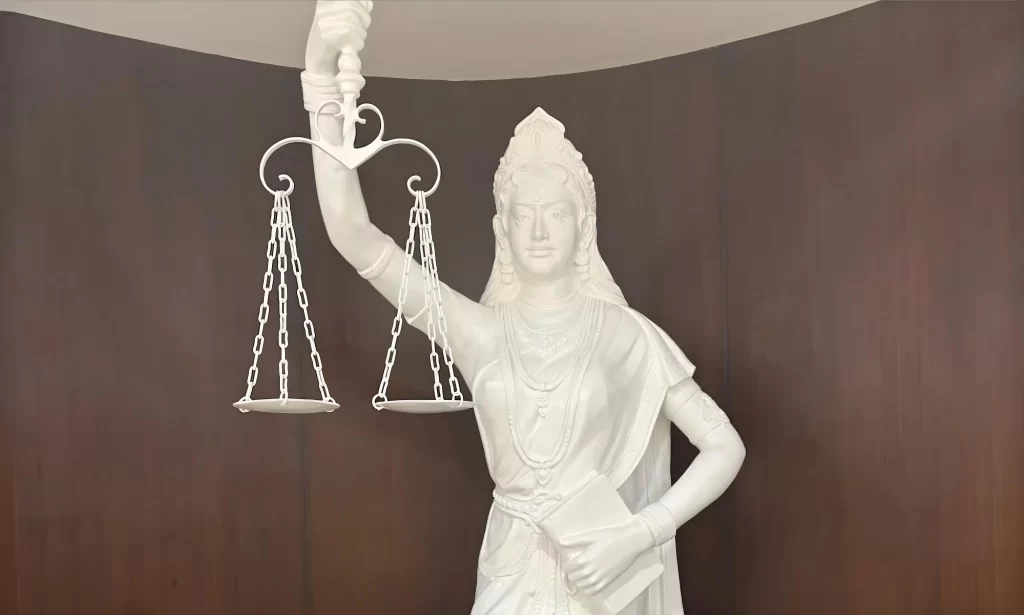The Supreme Court of India has introduced a new statue of Lady Justice, symbolizing that the law is not blind. This significant change, ordered by Chief Justice DY Chandrachud, replaces the blindfold traditionally worn by Lady Justice with open eyes. The statue also features the Indian Constitution in place of the sword, emphasizing justice that is aware, balanced, and no longer tied to colonial depictions.
The Supreme Court of India has unveiled a new statue of Lady Justice and this time, her eyes are open. Unlike the traditional depiction where Lady Justice wears a blindfold, symbolizing impartiality, the newly commissioned statue represents a shift in perspective. According to a report by NDTV, this change was ordered by Chief Justice DY Chandrachud as part of an effort to emphasize that “the law is not blind.”
In this modern interpretation, Lady Justice holds the Constitution in one hand instead of the sword, signifying that the law in India is focused on being just, fair, and conscious. The removal of the blindfold challenges the colonial-era symbolism of impartiality, offering a new vision where justice remains impartial but aware.
A Shift from Tradition
Lady Justice has historically been depicted as a figure wearing a blindfold, holding scales in one hand and a sword in the other. This imagery was deeply symbolic. The blindfold indicated that justice should be delivered without bias—regardless of an individual’s wealth, power, or status. The scales symbolized fairness and balance in judgment, while the sword represented the force and authority of the law.
However, the Supreme Court’s new statue has removed the blindfold, sending a clear message that justice in India is now aware, deliberate, and mindful. It no longer subscribes to the idea of blind justice but rather seeks to embody a justice system that is informed, fair, and equitable.
Symbolic of a New Era
This transformation is more than just a change in aesthetics. The new statue stands tall in the Supreme Court’s Judges’ Library, symbolizing a break from colonial traditions and the embracing of a new era for India’s legal system. By replacing the sword with the Constitution, the message conveyed is that the law is rooted in India’s guiding principles rather than punitive measures.
The scales remain intact, still representing the balance and fairness that is essential to the legal process. However, the absence of the blindfold marks a new direction—one that suggests that justice can be both impartial and attentive.
Moving Away from Colonial Legacy
The introduction of this statue could be seen as an attempt to leave behind the colonial legacy associated with the blindfolded Lady Justice. In post-colonial India, there is a growing sense that many of the institutions and symbols inherited from the British era no longer reflect the values or aspirations of modern India.
As such, the removal of the blindfold may represent a shift in how the Indian judiciary views itself and its role in society. It suggests that the legal system is evolving—becoming more aware of the realities it faces, more empathetic, and more in tune with the needs of its people.
Message of Fairness and Awareness
While the traditional Lady Justice was impartial and objective, the new interpretation reinforces that justice is not just about fairness; it is also about awareness. As the Indian legal system continues to modernize, this symbolism reflects the need for a justice system that is not blind to the nuances of modern society, but rather one that sees, understands, and responds with fairness and empathy.
In a rapidly changing world, the message behind the new statute is clear—justice in India is not blind, and the law is designed to serve the people with both fairness and insight. With the Constitution in hand, this Lady Justice represents a more inclusive, conscious approach to legal processes in India.
The unveiling of the new Lady Justice statue at the Supreme Court marks a pivotal moment in Indian legal history. It is a visual representation of the judiciary’s desire to move beyond outdated symbols and embrace a future where justice is conscious, balanced, and guided by the Constitution. This bold statement, commissioned by Chief Justice DY Chandrachud, reflects a commitment to ensuring that justice in India is fair, aware, and deeply rooted in the country’s foundational principles.

